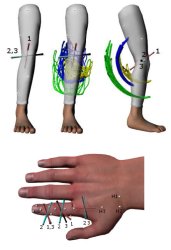Robust Estimation of Dominant Axis of Rotation
| Lillian Y. Chang | Nancy Pollard |
Journal of Biomechanics (2007)

A simple method is developed for robustly estimating a fixed dominant axis of rotation (AoR) of anatomical joints from surface marker data. Previous approaches which assume a model of circular marker trajectories use plane-fitting to estimate the direction of the AoR. However, when there is limited joint range of motion and rotation due to a second degree of freedom, minimizing only the planar error can give poor estimates of the AoR direction. Optimizing a cost function which includes the error component within a plane, instead of only the component orthogonal to a plane, leads to improved estimates of the AoR direction for joints which exhibit additional rotational motion from a second degree of freedom. Results from synthetic data validation show the ranges of motion where the new method has lower estimation error compared to plane-fitting techniques. Estimates of the flexion-extension AoR from empirical motion capture data of the knee and index finger joints were also more anatomically plausible.
Lillian Y. Chang, Nancy Pollard (2007). Robust Estimation of Dominant Axis of Rotation. Journal of Biomechanics, 40(12), 2707--2715.
@article{Chang:2007:AoR,
author = "Lillian Y. Chang and Nancy Pollard",
title = "Robust Estimation of Dominant Axis of Rotation",
year = "2007",
journal = "Journal of Biomechanics",
volume = "40",
number = "12",
pages = "2707--2715",
}

